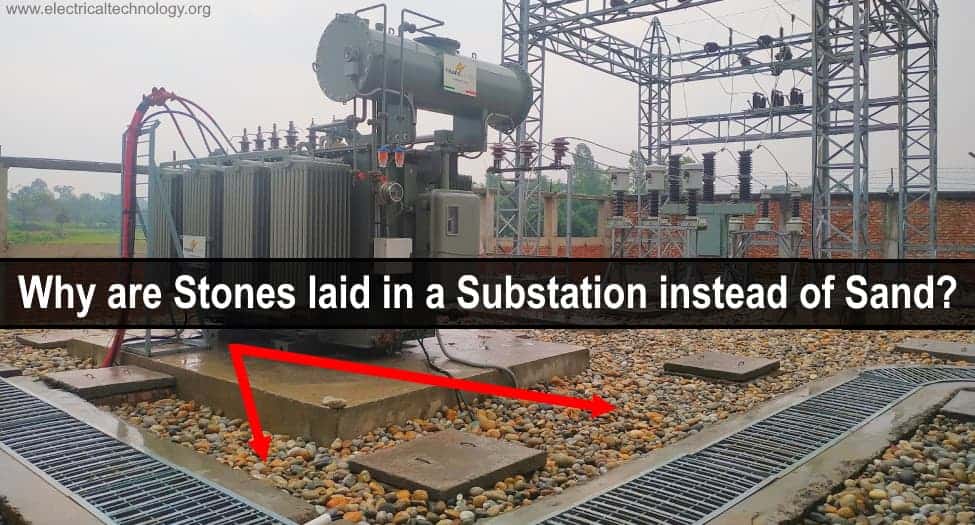Why are Stones Used in an Electrical Substation?
Why are Stones, Pebbles, Grit and Gravel used in an a Switchyard?
In an electrical substation, there are multiple devices and equipment such as power and distribution transformers, transmission lines, Potential and Current transformers, Isolators etc. are grounded. Beside the grounding in a substation, we will discuss why grit and pebbles are used in a substation and what is the reason behind doing so?
There are multiple factors to use stones in the switchyard while designing of multiple earthing and grounding in a substation grid.
The main reason to lay gravel in the substation yard is to reduce Ground Potential Rise (GPR) AKA Step Voltage and Touch Voltage which may be defined as follow:
- Ground Potential Rise (GPR): The maximum electrical potential that a substation grounding grid may attain relative to a distant grounding point assumed to be at the potential of remote earth. This voltage, GPR, is equal to the maximum grid current times the grid resistance.
- Step Voltage (Es) is defined as the maximum potential difference that exists between the feet when a fault current flows in the body.A particular case of step voltage is the Transferred voltage (Etransferred) where a voltage is transferred into or out of the substation from or to a remote point external to the substation site. It is usual to consider a distance of one meter between the metallic structure and the point on the ground.
- Touch Voltage (Et) can be defined as the maximum potential difference that exists between an earthed metallic structure capable of being touched by the hand and any point of the ground, when a fault current flows.
As we know that step and touch voltage increases during the short circuit current and the resistivity of stones are considerably high as compared to other materials which can be found easily and everywhere. That’s why stones or gravel are laid in the substation to reduce the step potential and touch potential in case of maintenance or working on live equipment.
The following table shows the resistivity of different materials such as stones and sand etc.
| Material | Resistivity (Ωm) |
| Clay & Saturated Silt | <100 |
| Sandy Clay & Wet Silty Sand | 100-250 |
| Clayey Sand & Saturated Sand | 250-500 |
| Sand | 500-1500 |
| Weathered Rock | 1000-2000 |
| Gravel | 1500-5000 |
| Sound Rock | 1500-10000 |
Reasons to Use Stones in a Substation & Electrical Switchyard
Following are the specific reasons and factors to use stones instead of other materials.
- There is a BIG NO to the grass as they and other weeds and tiny plants grow which makes troubles in case of rain and humidity. In addition, the dry grass may catch fire and there are chances of short circuits during the operation.
- Using stones in the switchyard provides protection against the entry of wildlife animals and snakes, lizards, rats etc. in the substation area.
- Gravel yards prevent the formation of puddles and accumulation of water in the switchyard which is not a good sign in case of high voltage equipment.
- Pebbles and stones are more shock resistant as compared to grass and sand therefore, it will reduce the vibration in the transformer (caused by Magnetostriction in core) and special cases like earthquakes etc.
- Stone and gravel increase the resistance of soil which leads to reducing the limit of touch and step potential. It also prevents the growth of small plants and weeds (which cause to reduce the touch and step potential) inside the substation This way, it reduces the risk of electric shock hazard during general maintenance and operational works.
- Stone in the switchyard improves the overall working conditions and smooth operation of an electric substation and protection against electric shock in existing of proper grounding systems.
Related Posts:
- Why are US Homes Wired Using Solid Wire rather than Stranded Wire?
- Why are Outlets and Receptacles in Hospitals Upside Down?
- Why Do Electronic Circuits Use DC Current instead of AC?
- Why Don’t Birds and Squirrels Get Electrocuted on Power Lines?
- Why is Electric Power Transmission Multiple of 11 i.e. 11kV, 22kV, 66kV etc.?
- Why Earth Pin is Thicker and Longer in a 3-Pin Plug?
- Which Bulb Glows Brighter When Connected in Series and Parallel & Why?
- Why Do Americans Use Gas Kettles Instead of Electric Kettles?
- Why Does Japan Use Both 50Hz and 60Hz in Its Power System?
- Why You Should Never Buy or Use Male-to-Male Extension Cords
- Why is the Neutral Wire Size Smaller than the Phase Wire?
- Why is the Ground Wire Size Smaller than the Hot Wire?
- Why Don’t Bug Zappers and Fly Swatter Bats Kill Humans?
- Why is Copper Rod Used as Ground Rod in Grounding / Earthing System?
- Why is the Ground Wire Always Positioned Above the Overhead
- Why is the Grounding Wire Bare and Not Insulated?
- Why is the Standard Frequency 60 Hz in the US & 50 Hz in the EU?
- Why is the Standard Voltage in the US 120V/240V and 230V in the EU?









very appreciated
Really explanation is cleared to understand
This is really helpful and I would like to get more information related to electrical engineering topics.
Thank you.